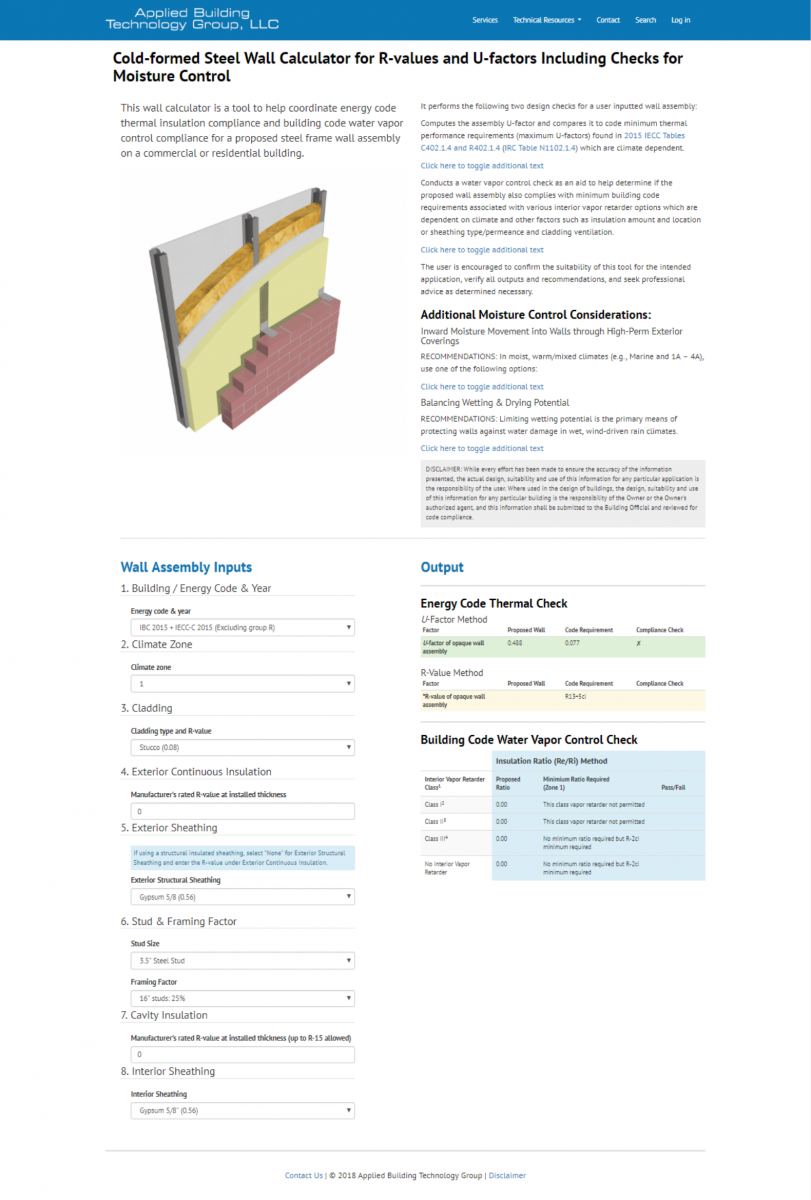The Applied Building Technology Group has developed a new tool to aid and simplify the design of code compliant steel stud walls. The Steel Wall Calculator takes a description of a wall and does two code compliance checks: one for thermal behavior, and one for moisture control
Previously, the wood wall calculator allowed specifiers to design wood walls. The steel wall calculator takes the same functionality and applies it to steel stud walls, which make up a large percentage of commercial construction.
Thermal Code Compliance
The steel wall calculator offers two methods for complying with the thermal code: the U-factor method, and the R-value method. For the U-factor method, the calculator tool makes use of the correction factor calculation method laid out in the commercial provisions of the IECC (section C402.1.4.1). In this method, the U-factor is computed using the following equation:

where R is the nominal R-value of the cavity insulation, E is a correction factor based on the steel framing, and Rx is the sum of the R-values of the rest of the wall layers (continuous insulation, sheathing, etc.). Essentially, the method assumes that the layer of steel studs and cavity insulation can be treated as a single homogenous material with an R-value significantly lower than the nominal cavity insulation value due to thermal bridging through the steel.
 There are other code-approved U-factor calculation methods. The IECC residential provisions require a “series-parallel path calculation method” (section R402.2.6). The ASHRAE Handbook of Fundamentals recommends the Modified Zone method as the appropriate series-parallel path method for steel stud walls. The Modified Zone method was evaluated for use in the steel calculator, but revealed some unexplained biases when applied to certain wall configurations. Therefore, special care has been taken to ensure that the equivalent wall U-factors as determined by the calculator conform closely to available testing data such as reported in the 2015 edition of AISI’s Thermal Design and Code Compliance for Cold-Formed Steel Walls. It was also checked for consistency with R-values and U-factors as found in the IECC and ASHRAE 90.1 standard.
There are other code-approved U-factor calculation methods. The IECC residential provisions require a “series-parallel path calculation method” (section R402.2.6). The ASHRAE Handbook of Fundamentals recommends the Modified Zone method as the appropriate series-parallel path method for steel stud walls. The Modified Zone method was evaluated for use in the steel calculator, but revealed some unexplained biases when applied to certain wall configurations. Therefore, special care has been taken to ensure that the equivalent wall U-factors as determined by the calculator conform closely to available testing data such as reported in the 2015 edition of AISI’s Thermal Design and Code Compliance for Cold-Formed Steel Walls. It was also checked for consistency with R-values and U-factors as found in the IECC and ASHRAE 90.1 standard.
Moisture Code Compliance
The moisture check makes recommendations for the types of interior vapor retarder that are appropriate for the given wall. These recommendations are based on building code requirements in the U.S. and Canada that, depending on climate, require a minimum ratio of continuous insulation to cavity insulation in the wall. Following these recommendations will help minimize moisture problems by controlling the risk of condensation within the wall cavity and promoting adequate drying to the interior as determined by the selected interior vapor retarder.
Designing Durable Walls
The steel wall calculator joins the wood wall calculator as a tool that greatly simplifies the wall design process. There’s no need to page through I-codes, or cross-reference with ASHRAE except as needed to compare and confirm results. Simply enter your wall, and see if it complies. Also, it is easy to see how adding insulation or changing wall materials can improve the design, helping you get the most bang for your buck. Try out the calculator today!
For additional information, review the following articles, as well as the previous videos in this series:
Perfect Wall Articles
- Creating the ‘Perfect Wall’: Simplifying Water Vapor Retarder Requirements to Control Moisture
- Perfect Walls are Perfect, and Hybrid Walls Perfectly Good
- Wood Framed Wall Insulation Calculator Explained
- New Wall Design Calculator for Commercial Energy Code Compliance
- Energy Code Math Lesson: Why an R-25 Wall is Not Equal to a R-20+5ci
- Continuous Insulation Solves Energy Code Math Problem
Video Series
- Fear Building Envelopes No More with This Website & Videos
- Video: Thermodynamics Simplified Heat Flows from Warm to Cold
- Video: Moisture Flow Drives Water Induced Problems
- Video: How the 'Perfect Wall' Solves Environmental Diversity
- Video: How Important Is Your WRB?
- Video: A Reliably Perfect Wall Anywhere
- Video: The Best Wall We Know How to Make
- Video: How to Insulate with Steel Studs
- Video: Thermal Bridging and Steel Studs
- Video: Better Residential Energy Performance with Continuous Insulation
- Video: How to (Not) Ruin a Perfectly Good Wall
- Video: Tar Paper and Continuous Insulation? No Problem!
- Video: Do CI and WRBs Go Together?
- Video: Assess Your 'Perfect Wall' Using Control Layers
